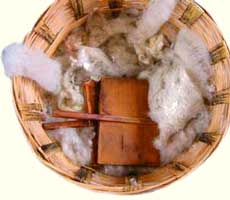|
The Zapotec weavers of Teotitlan are justly famous for their carpets.
For centuries families have handed down the weaving tradition to their
children with many families going back six and seven generations. But
a fresh breeze of creativity is blowing through the village and a new
generation of weavers is taking up the carpet making tradition.
NEW: Short Video of Demetrio and Eric Mindling
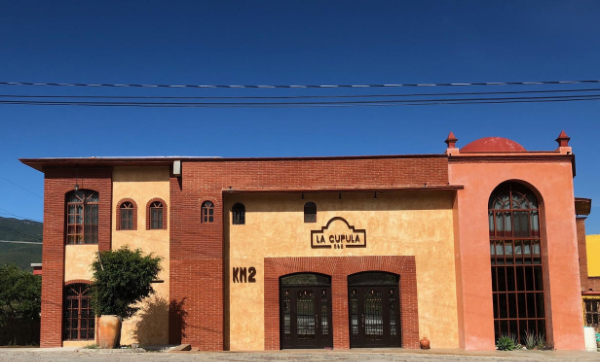
One of the most renowned of this next generation is Demetrio Bautista
Lazo who, like most of the younger weavers of the community, grew up at
his parents’ knees weaving rugs using the popular aniline dyes of
the 1960s and 70s. But times have changed and so has the marketplace.
While this youthful weaver looks forward in his designs, he is looking
back generations for the rich hues and dying techniques of his ancestors.
The happy results are rugs that seem to embrace both the future and the
past.
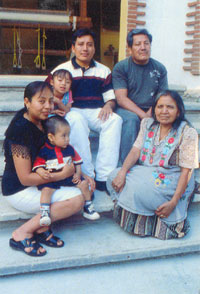
Demetrio with his parents Gaspar Bautista and Irene Lazo,
his wife Maribel Alavez Vasques, and their children Jesica and Victor.
For Demetrio the process of making a rug begins far above the village.
It is here in the high meadowlands that he comes to gather the flowers
and herbs that he’ll use to make many of the dyes he uses in the
gorgeous tapetes that are earning this young weaver an international reputation
and clientele. As the rainy season dwindles to a few brief weekly showers
there are only a few remaining days in which to harvest. Soon many of
the precious flowers which form the base of his dyes will be gone.
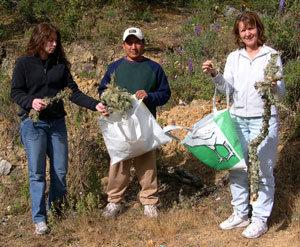
Collecting plants, moss, bark and leaves (December 2003)
“Right now I am obsessed with dyes,” he confides. “Every
day I’m working to create some special colors. And I have some very
interesting experiments I am conducting using different kinds of minerals.
This is the last time this season to get some of the flowers I use. Pretty
soon everything will drive.”
Rising at 5:00 a.m. he drives the curving road leading up out of town
into the highland forests. He has his secret spots to seek out his earthy
treasures and is always mindful about making sure that he doesn’t
take too many of any single herb, or flower, all the better to ensure
a continuing supply to meet his need.

“It is ironic,” he sighs, “But as much as I support the
use of vegetable and natural dyes, it would be easy - with all of the interest
in natural dyes - for weavers to completely take all of the wildflowers.
But I hope that is not going to happen.”
As a child growing up in Teotitlan, Demetrio, like most young people
within the community, learned to weave at the feet of his parents who
learned the artistry from their parents, and so on, for countless generations.
“We’ve always been weavers,” says Demetrio. “As far
back as my family has lived here, and that is a very long time.”

The Zapotec weavers of Teotitlán first wove on traditional backstrap
looms until the Dominican missionaries introduced harness looms and Roman
Catholicism during the 16th century. Today, the lovely Dominican church
which stands four-square in the center of town bears witness to the co-mingling
of the two cultures. Among the thousands of hand hewn rocks from which
the church is constructed are some which have been sculpted with the images
of Zapotec deities. Here and there are stones which feature the geometric
grecas that dominate Zapotec design.
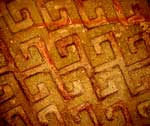
“You can look at the designs in the stones, and look at my carpets,
and still see the same designs,” Demetrio says. “We’ve
been using many of the same images for hundreds of years. But I’m
constantly refining my own ideas, and working to do something a little
bit different.”
And while certain Zapotec motifs will turn up in the rugs of many weavers,
not all rugs from Teotitlan are created equal. Many weavers will claim to
weave their carpets using all-natural dyes. There are, collectors claim,
only a handful of weavers in Teotitlan who work using all-natural dyes.
“It is a very labor intensive process,” says Demetrio. “I
used to have 70 nopales cacti for cochineal. But I have to ask myself,
am I a weaver or a farmer?”
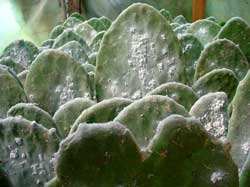 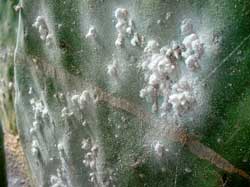 |
|
|
The rich and varied red dyes of cochineal that are the result of
the harvesting of the insect from the Nopal cactus once was so highly
valued that it was known as red gold. Its importation was closely
watched by the government, and exportation of the furry white insects
that live on the Nopal cactus was forbidden.
Today both cochineal and indigo remain the two most expensive,
and most desirable, of the natural dyes, and any rug which is predominantly
red could, very well, be woven from aniline dyes. If the deal seems
too good to be true it probably is.
|
  |
http://www.youtube.com/watch?v=9YzM1Edb6mo&feature=related
http://www.youtube.com/watch?v=Nqx5EHKfKtI
http://www.amazon.com/Perfect-Red-Empire-Espionage-Desire/dp/0060522755
http://en.wikipedia.org/wiki/Cochineal
But if the richness of red magnetizes many interested in Zapotec weaving,
Demetrio has broken new ground with a palette of greens that are unique.
With a great sense of pride he takes out a large carpet measuring approximately
six by eight feet and with the air of a magician about to pull the rabbit
out of his hat, he spreads it on the floor in a single expansive gesture.
The colors are subtle, as though he has indeed managed to create a magic
carpet. No newly mowed lawn ever looked this good. But the variations
in tone, and the simple way he uses other colors, browns, and blues, work
together to produce a carpet of dreams.
“This has been my surprise, working with these greens,” he
enthuses. “When I first started using this palette people thought
I was crazy. It was so different from what everyone else was doing. Now
people who laughed at me a few years ago are coming back and wanting to
buy my rugs.”
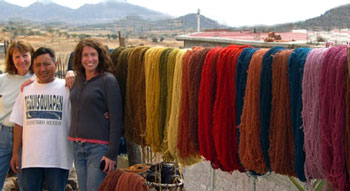
Ginny and Karim with Demetrio,
after a 10-day workshop on Natural Dyes in December 2003
And there are continual surprises. For while Lazo has to be equal parts
chemist, herbalist, and artist, carefully measuring the ph balance of
the dyes so as to remember his formulas for the future, sometimes something
will happen that will be a complete and pleasant surprise.
“I had this yarn that I had dyed and it turned out this really unattractive
shade of lavendar. I didn’t want to use it so I just threw it in
a corner. Well, months went by. It rained, and sat out in the sun, and
one day I went out and looked at it and it had turned into this beautiful
shade of purple. It was fantastic and I immediately used it,” he
laughs.
Right now Demetrio is balancing his work with dyes, with his weaving.
He is currently cooking a pot of rich brown dye, and ventures over to
the large outdoor kettle to check on the stew of wool, leaves, and other
secret ingredients.
On the loom inside is the design of a fantastic carpet in a Tree of Life
motif. The background of the carpet is a creamy lemon color, and when
finished, 120 birds will gather around the branches.

Demetrio’s workshop, which carries rugs from other members of his
extended family, is housed in a graceful building on the way into Teotitlán
and is also the home to the La Cupula restaurant and B&B. A visit
to see him might also include an impromptu lesson in the art and craft
of the manufacture of natural dyes.
Demetrio has two children and is hopeful that they will continue in the
family tradition.
And so a legacy of artistry is bound to continue.
-Gayle Hanson
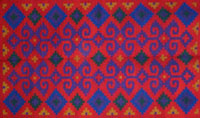
(by Will
Ackerman)
Whole towns outside of Oaxaca are dedicated to a single craft. This town
does woodcarving, this town pottery and this town weaving. Demetrio Bautista
Lazo weaves rugs in Teotitlan del Valle. There is a photo of him at age
seven sitting at his own loom. There would be other photos of his father
and his grandfather and his great grandfather back to 1735 in the same
pose if they’d had cameras. His work is exquisite, a subtle departure
from the purely traditional. Men and women, eighty people in the family,
all work in weaving. Everyone’s rugs are on display in a building
which features a fabulous family-run restaurant, B&B and the only
flush toilet for miles.
He shows me a photo taken of him and his father and his
brother standing at the end of a rug the size of a tennis court which
was recently sent to Los Angeles by DHL. These sales are keeping a craft
alive which all but vanished in the mid-20th century, a craft which is
based upon natural dyes and community.
 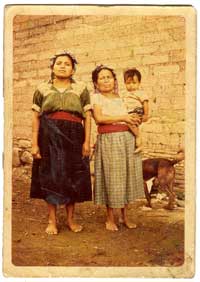
Demetrio in his Grandmother's arms (July 1973)
His son Victor has a black scorpion on a short leash (the black ones
only hurt like hell, it’s the yellow ones that will kill you). His
daughter Jessica poses for a photo on one of her grandfather’s rugs
which I buy. The red of the inner field is made from the most unlikely
source, an insect called Cochineal. The Cochineal obscures itself in a
white cotteny nest and feeds off of the prickly pear cactus. Someone in
the 18th century bumped up against one of these cactuses and after the
hail of profanity and removal of cactus spines from their flesh was complete
must have noticed that their clothing had been dyed a bright red. By adding
lime juice the red turns magically to orange before your eyes. The blue
of the rug is indigo. A tree; trunk, branches, bark, leaves and roots
is reduced to pulp, turned into a sludge with water and poured into large
drying trays and finally broken into clumps like natural blue charcoal.
One of the trees is growing in the courtyard of the restaurant. The yellow
is derived from a parasitic plant which I’ve seen in the deserts
outside of Death Valley which looks like a profusion of yellow angel hair
pasta so dense it obscures the host. In a nearby town it covers a Bougainvillea
tree across from the 14th century church. The town gardener knows not
to burn the stuff, but calls Demetrio. Demetrio can be reached by calling
+52 (951) 524-4090 or by email (I was stunned too, frankly). Please tell
them Will sent you.

Testimonials:
" Estimado Amigo Demetrio, Me dio mucho gusto el haber venido a
La Cupula y darme cuenta que existe otra opcion, muy diferente, para el
turismo oaxaqueño y la gente local. Fue un servicio excelente y
de calidad en los alimentos. Estoy segura que tendran mucho exito y los
vamos a recomendar ampliamente. Suerte! "
Olga Gomenz Flores, Directora de Promocion y Difusion
Municipio de Oaxaca de Juarez, Oaxaca.
" A most delightful experience for us! Your generosity of spirit,
your food and of course the rugs were of enormous joy. Many thanks. "
Diane and Greg Moyer
" Demetrio, You know how much i appreciate you, your tapetes - and
now the best mole, both rojo y negro, in Oaxaca. Everything here is magical,
delicioso and furthermore, may i adopt not only you, your wife and children
but your cocina? With much love and hasta la vista, mi amigo! May all
the gods go with you. "
Linda McDougal
Jan 2004
" To live, dye and weave with a Mexican Master Weaver was once a
dream that has become a true living experience. This trip has been the
first of many, I hope. Not only do I want to learn more about the art
and science of natural dyes and weaving, I want to cook with Maribel and
see Jessica and Victor grow up. I treasure being included in so many experiences
with your family and friends. Much Love. "
Rebecca Severeide, Portland, Oregon
(Teotitlan del Valle is believed to be the first Zapotec settlement in Oaxaca)
Send
us an Email
|
![]()
![]()
![]()
